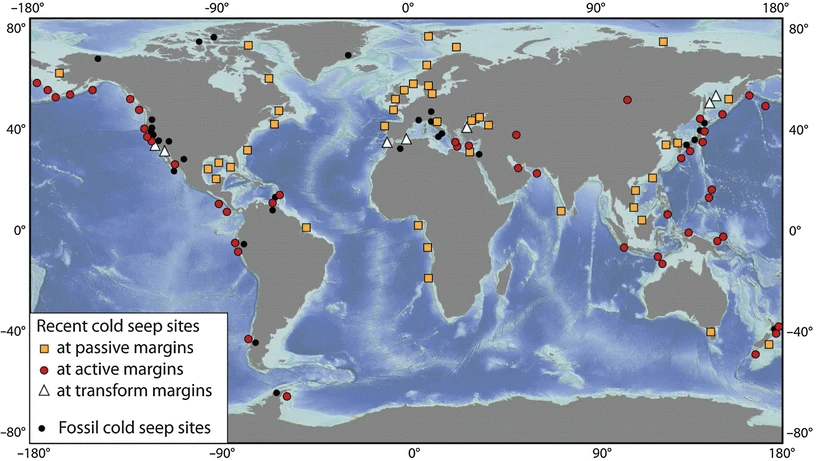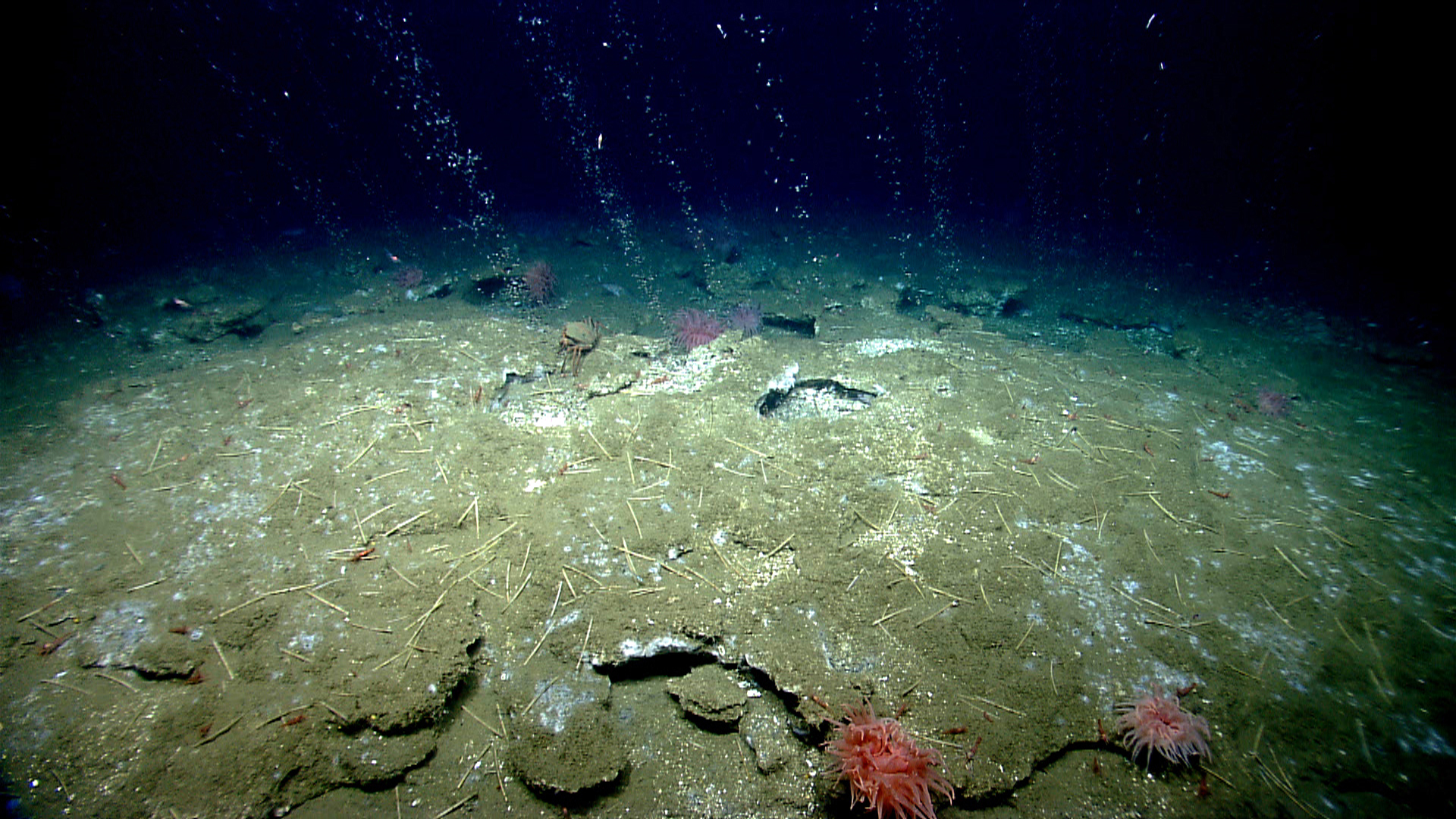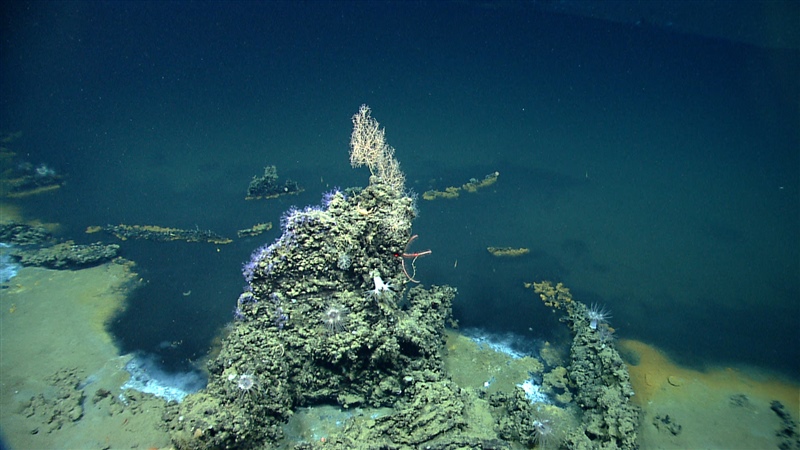Topic
Cold Seeps

Cold Seeps
Cold seeps are places throughout the global ocean where chemicals like hydrogen sulfide, methane, and other hydrocarbon-rich fluids and/or gases escape from cracks or fissures in the ocean floor. At these seep sites, the escaping fluid or gas is most often found to have temperatures close to that of the surrounding seawater. They are referred to as cold seeps to differentiate them from the super-heated fluids released from hydrothermal vents.
How do Seeps Form?
Scientists think that some cold seeps may have existed for thousands of years and that there are thousands of seep sites throughout the ocean. To date, cold seeps have been discovered in every ocean basin (at depths less than 50 meters [160 feet] and depths greater than 200 meters [660 feet]), occurring most frequently along continental margins, where coastal continental crust transitions into deeper oceanic crust. They are found at both tectonically active margins, where the transition from continental to oceanic plate occurs at a tectonic plate boundary, and at passive continental margins, where the transition from continental to oceanic plate is not located along the edge of a tectonic plate.
Cold seeps form when very large quantities of hydrocarbons are produced beneath the seafloor. Essentially, these hydrocarbons overflow or are pushed up through the seafloor when tectonic activity squeezes the sediments below the surface releasing the chemical compounds into the ocean.


Types of Seeps:
Cold seeps are also known as hydrocarbon seeps, methane seeps, marine seeps, and just seeps. Different types of seeps are classified by the escaping chemicals or the accompanying seafloor features at the sites.
Methane Seeps Methane and hydrogen sulfide bubble out of the seafloor, where they are digested by microbes, forming the base of a chemosynthetic food web. Learn more.
Methane and hydrogen sulfide bubble out of the seafloor, where they are digested by microbes, forming the base of a chemosynthetic food web. Learn more.
Brine Seeps (Brine Pools) Seawater that seeps up through thick salt layers beneath the seafloor, dissolving salt as it moves. The very salty water is more dense than the surrounding seawater, so it settles on the bottom forming underwater lakes. Learn more.
Seawater that seeps up through thick salt layers beneath the seafloor, dissolving salt as it moves. The very salty water is more dense than the surrounding seawater, so it settles on the bottom forming underwater lakes. Learn more.
Mud Volcano Volcanoes that occur in areas where there is a large amount of water-saturated, rapidly deposited, fine-grain sediment. It is believed that gas beneath the seafloor pushes mud from within the Earth upward toward the surface. Learn more.
Volcanoes that occur in areas where there is a large amount of water-saturated, rapidly deposited, fine-grain sediment. It is believed that gas beneath the seafloor pushes mud from within the Earth upward toward the surface. Learn more.
Oil Seeps Naturally occurring crude oil or gas escapes from the seafloor. It can be sticky and thick, like tar; or dark and fluid, like motor oil. Learn more.
Naturally occurring crude oil or gas escapes from the seafloor. It can be sticky and thick, like tar; or dark and fluid, like motor oil. Learn more.
Why are Seeps Important
The importance of cold seeps and the role they play in the larger marine ecosystem is just beginning to be understood. Investigating seep processes and their ecological significance is critical to resource management policies and to understanding our changing climate.
Essential Habitat
• Seeps provide habitat and food for a variety of deep-sea species.
• Seeps are recognized as essential breeding and nursery grounds for some species and help maintain species populations and ensure reproductive success.
Management of Natural Resources
• Discovery and mapping of ocean seeps is essential for understanding and managing renewable energy resources, like hydrocarbon and gas hydrate reservoirs.
• Microorganisms found at natural oil seeps are being studied for their potential to help degrade oil spills.
• Oil seeps data helps scientists create models to determine how weather, wind, tides, and currents affect oil movement.
The Carbon Cycle
• Cold seeps play a critical role in moving older carbon stored in the seafloor into the ocean, where it is consumed by bacteria and other microbes.
• Locating and studying seeps will expand our understanding of how seep sites impact oceanic, and possibly atmospheric, processes.